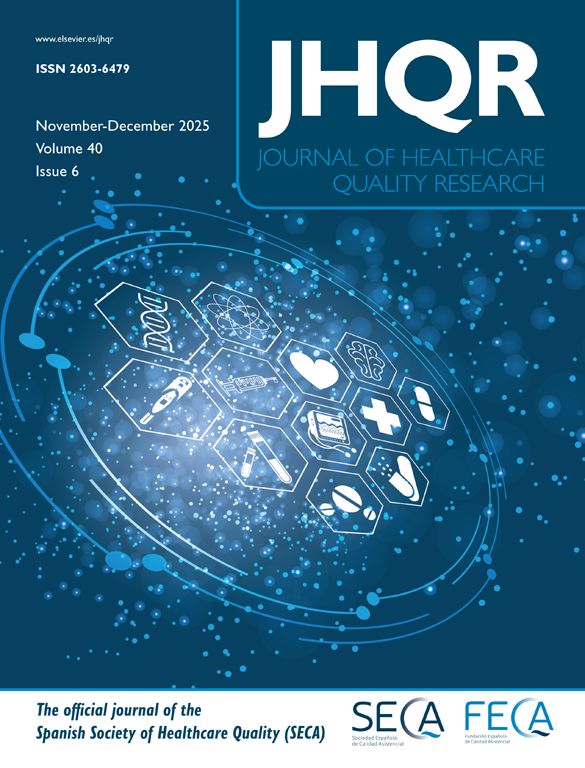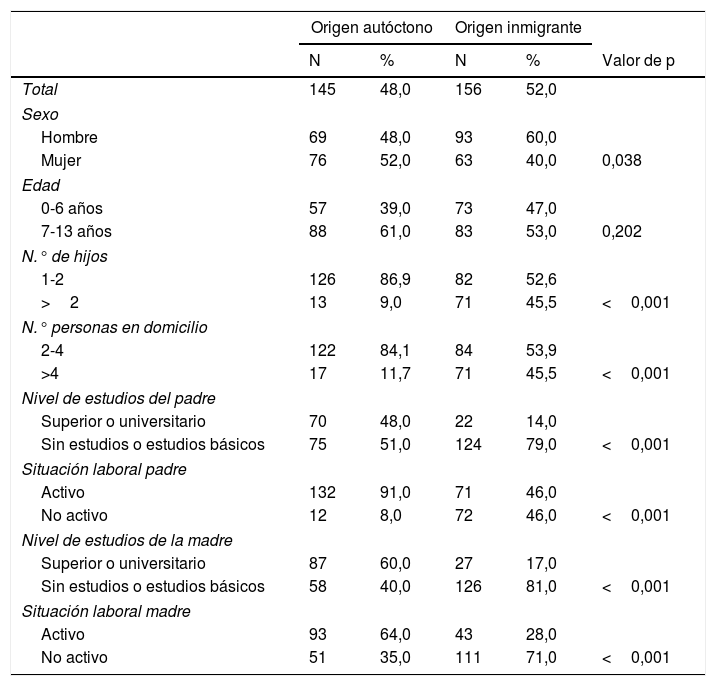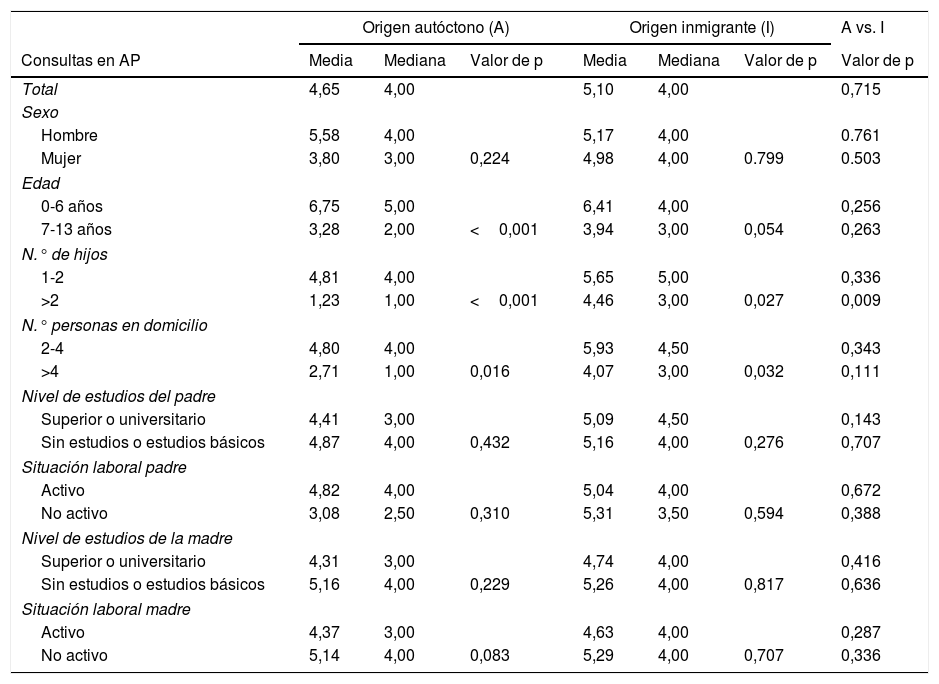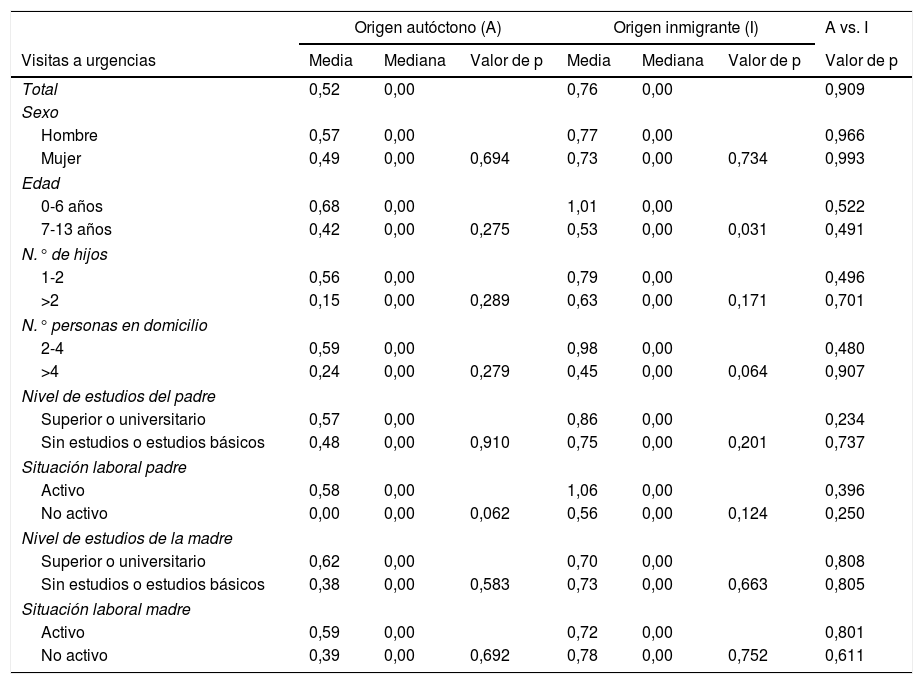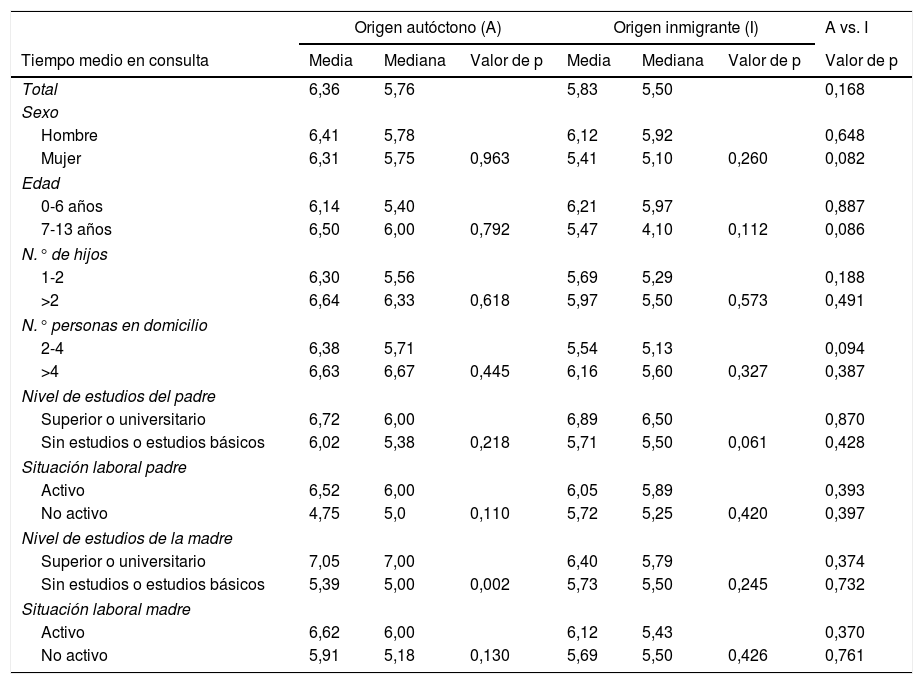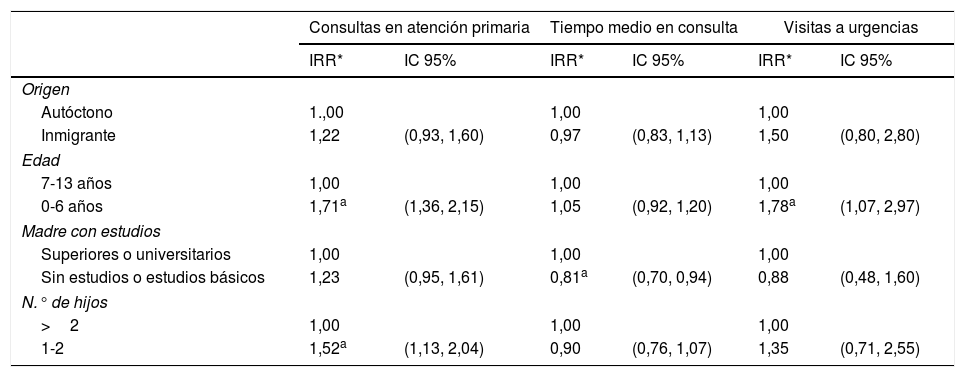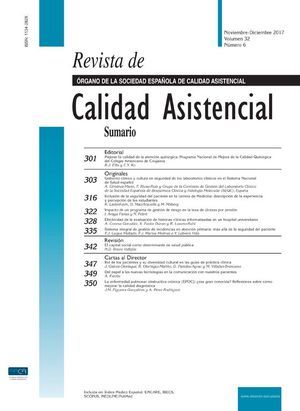El objetivo fue analizar la frecuentación y tiempo de consulta en atención primaria ordinaria y en urgencias pediátricas hospitalarias de la población pediátrica autóctona y de origen inmigrante, y su asociación con variables socioeconómicas.
Pacientes y métodosEl estudio observacional retrospectivo de cohortes se realizó en 301 niños de 2 comarcas de Guipúzcoa. La población inmigrante se representó siguiendo la proporción real por nacionalidades en 2011. La población autóctona respetó la misma distribución por edades que la población inmigrante. La muestra fue seleccionada por aleatorización simple. La frecuentación y tiempo de consulta se obtuvieron a través de las bases datos administrativas. Los datos socioeconómicos se obtuvieron a través de una encuesta presencial ad hoc, dirigida a los tutores de los sujetos a estudio.
ResultadosNo se observan diferencias en la frecuentación ni en la duración de las consultas. El perfil del niño significativamente más frecuentador a atención primaria ordinaria respondió a los niños de 0 a 6 años, con un hermano como máximo. Este perfil se repitió a la hora de asistir a urgencias hospitalarias. Por su parte, respecto al tiempo de consulta ambulatoria destacó la relación entre ser madres con estudios universitarios o superiores y realizar consultas más largas.
ConclusionesLa edad, el número de hermanos y el nivel de estudios de la madre son las variables que mejor han explicado la variabilidad en cuanto a la frecuentación y tiempo de consulta, afectando a ambos grupos de población infantil en el mismo sentido y por igual.
The aim of the study was to analyse the frequency and time of consultation in Primary Care and in paediatric hospital emergencies, between the native (Spanish-Born) paediatric population and children of immigrant origin, as well as its relationship with socioeconomic variables.
Patients and methodsThe retrospective observational cohort study was conducted on 301 children in two regions of the Basque Country (Gipuzkoa). The immigrant population was represented following the proportion of nationalities distribution in 2011. The native population had the same age distribution as the immigrant origin population. The sample was selected by simple randomisation. Frequency and consultation time data were obtained through the administrative databases. An ad hoc face-to-face survey, addressed to the guardians of the study subjects, was carried out in order to obtain socio-economic data.
ResultsNo differences were observed in frequency or mean duration of the consultation visits. The profile of the significantly more frequent child in Primary Care responded to children from 0 to 6 years old, with maximum one sibling. This profile was repeated when attending hospital emergencies. On the other hand, as regards outpatient consultation time, the relationship between mothers with a high education level or university degree and longer duration of Primary Care visits was highlighted.
ConclusionsAge, the number of siblings, and mother's education level were the variables that have best explained the variability in terms of frequency and time of consultation, affecting both groups of children equally and in the same direction.
La recuperación de los flujos migratorios con destino a la Comunidad Autónoma Vasca, y su contribución a la sostenibilidad de la tasa de natalidad, ha sido considerado como un acontecimiento demográfico de extraordinaria importancia acaecido a comienzos del presente siglo en este territorio histórico1. Este nuevo escenario supone un reto a la convivencia multicultural en la sociedad vasca y española, que concibe al inmigrante como competidor directo en el acceso a los recursos sociales; entre ellos destaca el sanitario, que ve mermada su calidad de servicio entendida en términos de tiempo efectivo del que dispone cada paciente2.
Ciertamente, la evidencia científica nacional concluye que en la mayoría de los casos no se observan diferencias significativas en el consumo de tiempo sanitario entre población autóctona e inmigrante3. Sin embargo, cuando se analiza la percepción del profesional a este respecto los resultados son los opuestos: en general, se considera que los tiempos que la población inmigrante necesita son mayores, al menos hasta que el conocimiento entre el médico y el paciente se consolida y se da un escenario de normalización de las relaciones a todos los niveles, incluyendo el ámbito cultural4. Varios estudios realizados en distintas comunidades autónomas5–7 subrayan que el colectivo sanitario comparte la impresión de que la entrada de inmigrantes en el sistema sanitario ha dado como resultado un aumento notable de la presión asistencial soportada individualmente por cada profesional y, en consecuencia, el decremento en la calidad asistencial globalmente prestada8,9.
Un estudio elaborado en el País Vasco en 20094 señalaba a la población pediátrica inmigrante como colectivo especialmente «hiperfrecuentador». De ser cierto, sería pertinente profundizar en el origen de este comportamiento. Sin embargo, hasta la fecha, la producción científica en el ámbito sanitario a nivel nacional con población pediátrica como población objeto de estudio es escasa10, especialmente centrada en diseños transversales, y las existentes muestran limitaciones con respecto a las franjas de edad preescolar y escolar11. El objetivo del presente estudio fue, por tanto, analizar si la población autóctona y de origen inmigrante presenta un comportamiento sanitario diferenciado en cuanto a frecuentación y tiempo de consulta, y de qué forma algunas variables socioeconómicas se relacionan con un consumo mayor de tiempo sanitario.
MetodologíaEste fue un estudio descriptivo longitudinal realizado en la población pediátrica de las Organizaciones Sanitarias Integradas del Alto y Bajo Deba, en Gipúzcoa (España), que acudió (o no) a consulta ordinaria de atención primaria (quedan excluidas, por tanto, las revisiones del niño sano) y a urgencias hospitalarias entre diciembre de 2011 y 2012.
La Delegación Territorial de Sanidad, previa consulta y aceptación del CEIC, facilitó la relación de población pediátrica de ambas demarcaciones en forma encriptada de donde se extrajo, por aleatorización simple, los individuos participantes, respetando en todo momento la privacidad de los datos.
De una población pediátrica total aproximada a los 21.203 sujetos menores de 14 años se seleccionó una muestra de 156 niños de origen inmigrante a partir de la distribución real de la población pediátrica inmigrante por municipio de ambas Organizaciones Sanitarias Integradas, que aportó el Observatorio Vasco de Inmigración (Ikuspegi), según datos de 2011. En proporción a las nacionalidades existentes se incluyeron un 40% de magrebíes, un 30% de latinoamericanos, un 5% de árabes, un 2,5% de subsaharianos, un 2,5% de orientales, un 10% de países europeos occidentales y un 10% de países europeos del este. Se seleccionó, a continuación, una muestra de 145 niños autóctonos con la misma distribución etaria (lactantes de 0 a 2 años, preescolares de 3 a 6 años y escolares de 7 a 13 años) porque se considera que la edad, a diferencia del sexo, puede tener una influencia significativa en su salud y, por tanto, en los resultados finales. Al mismo tiempo, se confeccionó un cuestionario por bloques temáticos del que, mediante una entrevista personal con los padres de los niños estudiados, se extrajo información acerca de: perfil demográfico y socioeconómico de los progenitores, composición de los hogares, valoración del Sistema Vasco de Salud, valoración del/la pediatra, hábitos y usos del sistema sanitario, hábitos alimenticios, higiene, ocio y sueño del niño lactante, preescolar y escolar y adaptación del niño inmigrante a su entorno. La encuesta, dirigida a las madres y padres, fue realizada de forma presencial el último trimestre del año 2013 por profesionales con amplia experiencia previa y que fueron específicamente formados para este proyecto. Para garantizar la homogeneidad de las encuestas esta fue previamente redactada, incluyendo los comentarios a realizar por el encuestador en cada sección. Todos los participantes otorgaron consentimiento explícito a participar en el proyecto de investigación.
Para el cálculo del tamaño muestral se realizó un estudio piloto con 200 niños del ambulatorio de Eibar, donde se obtuvo una media de frecuentación anual de 3,5 visitas con una desviación típica de 4,5. Se estimó que eran necesarios 150 individuos por grupo, con el objetivo de detectar la diferencia en medias estandarizadas de 0,364, asumiendo la desviación estándar igual para ambos grupos con potencia del 80%, nivel de significación del 5% y 20% de pérdidas.
A partir de las bases de datos administrativas del Servicio Vasco de Salud se obtuvieron los datos de frecuentación y tiempo de consulta de los pacientes seleccionados.
Análisis estadísticoInicialmente se compararon las distribuciones de las variables a estudio en la población de origen autóctono y la población de origen inmigrante. Dado que todas las variables fueron analizadas de forma dicótoma se aplicó el test exacto de Fisher para todas ellas.
Dado que el número de consultas y el tiempo medio de consultas no siguen una distribución normal, no es adecuado comparar las medias de las poblaciones de origen inmigrante o autóctono. Por tanto, se optó por mostrar tanto las medias como las medianas y realizar la comparación estadística de las medianas aplicando la prueba U de Mann-Whitney para variables dicotómicas.
Por otra parte, se midió la asociación entre las variables socioeconómicas y el consumo de recursos utilizando la prueba U de Mann-Whitney, de la misma forma que se mencionaba anteriormente para la comparación de medianas.
Finalmente, se aplicaron modelos lineales generalizados para el análisis multivariante. En esta regresión se asumió la distribución binomial negativo con link logarítmica para la predicción del número de consultas de atención primaria; sin embargo, se consideró adecuada la regresión lineal ordinaria para el número de atenciones en urgencias y el tiempo medio de consulta. En las 3 regresiones se incluyeron todas las variables que resultaron asociadas a las variables objetivo en el paso anterior.
ResultadosSe analizaron los datos socioeconómicos de una muestra total de 301 niños de ambas comarcas sanitarias; concretamente, 145 de origen autóctono y 156 inmigrantes. La presencia de varones en la población inmigrante fue mayor que en la autóctona, y el 43% de los niños en la muestra eran menores de 7 años. En cuanto a las variables socioeconómicas que resultaron significativamente diferentes entre ambas poblaciones destacaron: el número de hijos en la familia, el número de personas en el domicilio, el nivel de estudios del padre y de la madre y la situación laboral del padre y de la madre (tabla 1). Los datos reflejan que el 60% de las madres y el 48% de los padres de los niños autóctonos tienen estudios universitarios, frente al 17% y 14% de los inmigrantes, respectivamente. En el caso de estos últimos la mayoría o no tienen estudios o solo tienen estudios básicos. La situación de desempleo se acentúa también en los progenitores inmigrantes, con el 71% de las madres y el 46% de los padres en paro, frente al 35% de madres autóctonas y el 8% de los padres. Otra diferencia importante la encontramos en la composición de los hogares: las familias de origen inmigrante son notablemente mayores, tanto en número de miembros en general (45% de familias inmigrantes con más de 4 miembros frente al 12% de autóctonas) como en número de hijos (un 45% de progenitores inmigrantes con más de 2 hijos, frente un 9% de los autóctonos).
Comparación de las características socioeconómicas en las poblaciones a estudio
| Origen autóctono | Origen inmigrante | ||||
|---|---|---|---|---|---|
| N | % | N | % | Valor de p | |
| Total | 145 | 48,0 | 156 | 52,0 | |
| Sexo | |||||
| Hombre | 69 | 48,0 | 93 | 60,0 | |
| Mujer | 76 | 52,0 | 63 | 40,0 | 0,038 |
| Edad | |||||
| 0-6 años | 57 | 39,0 | 73 | 47,0 | |
| 7-13 años | 88 | 61,0 | 83 | 53,0 | 0,202 |
| N.° de hijos | |||||
| 1-2 | 126 | 86,9 | 82 | 52,6 | |
| >2 | 13 | 9,0 | 71 | 45,5 | <0,001 |
| N.° personas en domicilio | |||||
| 2-4 | 122 | 84,1 | 84 | 53,9 | |
| >4 | 17 | 11,7 | 71 | 45,5 | <0,001 |
| Nivel de estudios del padre | |||||
| Superior o universitario | 70 | 48,0 | 22 | 14,0 | |
| Sin estudios o estudios básicos | 75 | 51,0 | 124 | 79,0 | <0,001 |
| Situación laboral padre | |||||
| Activo | 132 | 91,0 | 71 | 46,0 | |
| No activo | 12 | 8,0 | 72 | 46,0 | <0,001 |
| Nivel de estudios de la madre | |||||
| Superior o universitario | 87 | 60,0 | 27 | 17,0 | |
| Sin estudios o estudios básicos | 58 | 40,0 | 126 | 81,0 | <0,001 |
| Situación laboral madre | |||||
| Activo | 93 | 64,0 | 43 | 28,0 | |
| No activo | 51 | 35,0 | 111 | 71,0 | <0,001 |
En el análisis univariante los resultados muestran una frecuentación similar para niños autóctonos e inmigrantes. En la tabla 2 se puede observar que tanto la población autóctona como inmigrante ha acudido una mediana de 4 veces al año a la consulta pediátrica ordinaria de atención primaria. En todo caso, independientemente del origen de los progenitores, los niños menores de 7 años han ido casi 3 veces más de media que el resto. Una frecuentación significativamente diferente entre autóctonos e inmigrantes se observa, sin embargo, entre las familias que tienen más de 2 hijos. En este caso, el niño inmigrante ha acudido al pediatra del centro de salud 3 veces más de media que el niño autóctono.
Asociación de las variables socioeconómicas con la frecuentación a atención primaria
| Origen autóctono (A) | Origen inmigrante (I) | A vs. I | |||||
|---|---|---|---|---|---|---|---|
| Consultas en AP | Media | Mediana | Valor de p | Media | Mediana | Valor de p | Valor de p |
| Total | 4,65 | 4,00 | 5,10 | 4,00 | 0,715 | ||
| Sexo | |||||||
| Hombre | 5,58 | 4,00 | 5,17 | 4,00 | 0.761 | ||
| Mujer | 3,80 | 3,00 | 0,224 | 4,98 | 4,00 | 0.799 | 0.503 |
| Edad | |||||||
| 0-6 años | 6,75 | 5,00 | 6,41 | 4,00 | 0,256 | ||
| 7-13 años | 3,28 | 2,00 | <0,001 | 3,94 | 3,00 | 0,054 | 0,263 |
| N.° de hijos | |||||||
| 1-2 | 4,81 | 4,00 | 5,65 | 5,00 | 0,336 | ||
| >2 | 1,23 | 1,00 | <0,001 | 4,46 | 3,00 | 0,027 | 0,009 |
| N.° personas en domicilio | |||||||
| 2-4 | 4,80 | 4,00 | 5,93 | 4,50 | 0,343 | ||
| >4 | 2,71 | 1,00 | 0,016 | 4,07 | 3,00 | 0,032 | 0,111 |
| Nivel de estudios del padre | |||||||
| Superior o universitario | 4,41 | 3,00 | 5,09 | 4,50 | 0,143 | ||
| Sin estudios o estudios básicos | 4,87 | 4,00 | 0,432 | 5,16 | 4,00 | 0,276 | 0,707 |
| Situación laboral padre | |||||||
| Activo | 4,82 | 4,00 | 5,04 | 4,00 | 0,672 | ||
| No activo | 3,08 | 2,50 | 0,310 | 5,31 | 3,50 | 0,594 | 0,388 |
| Nivel de estudios de la madre | |||||||
| Superior o universitario | 4,31 | 3,00 | 4,74 | 4,00 | 0,416 | ||
| Sin estudios o estudios básicos | 5,16 | 4,00 | 0,229 | 5,26 | 4,00 | 0,817 | 0,636 |
| Situación laboral madre | |||||||
| Activo | 4,37 | 3,00 | 4,63 | 4,00 | 0,287 | ||
| No activo | 5,14 | 4,00 | 0,083 | 5,29 | 4,00 | 0,707 | 0,336 |
En cuanto a la atención en el servicio de urgencias hospitalarias en la tabla 3 se observa que menos del 30% de la población ha sido atendida en el servicio de urgencias pediátricas a lo largo del año, sin diferencias estadísticamente significativas entre los orígenes de las poblaciones a estudio. Y en este caso, nuevamente, los niños menores de 7 años han acudido un mayor número de veces a urgencias hospitalarias, aunque en el grupo específico del niño inmigrante los menores de 7 años han acudido significativamente más.
Asociación de las variables socioeconómicas con la frecuentación a urgencias
| Origen autóctono (A) | Origen inmigrante (I) | A vs. I | |||||
|---|---|---|---|---|---|---|---|
| Visitas a urgencias | Media | Mediana | Valor de p | Media | Mediana | Valor de p | Valor de p |
| Total | 0,52 | 0,00 | 0,76 | 0,00 | 0,909 | ||
| Sexo | |||||||
| Hombre | 0,57 | 0,00 | 0,77 | 0,00 | 0,966 | ||
| Mujer | 0,49 | 0,00 | 0,694 | 0,73 | 0,00 | 0,734 | 0,993 |
| Edad | |||||||
| 0-6 años | 0,68 | 0,00 | 1,01 | 0,00 | 0,522 | ||
| 7-13 años | 0,42 | 0,00 | 0,275 | 0,53 | 0,00 | 0,031 | 0,491 |
| N.° de hijos | |||||||
| 1-2 | 0,56 | 0,00 | 0,79 | 0,00 | 0,496 | ||
| >2 | 0,15 | 0,00 | 0,289 | 0,63 | 0,00 | 0,171 | 0,701 |
| N.° personas en domicilio | |||||||
| 2-4 | 0,59 | 0,00 | 0,98 | 0,00 | 0,480 | ||
| >4 | 0,24 | 0,00 | 0,279 | 0,45 | 0,00 | 0,064 | 0,907 |
| Nivel de estudios del padre | |||||||
| Superior o universitario | 0,57 | 0,00 | 0,86 | 0,00 | 0,234 | ||
| Sin estudios o estudios básicos | 0,48 | 0,00 | 0,910 | 0,75 | 0,00 | 0,201 | 0,737 |
| Situación laboral padre | |||||||
| Activo | 0,58 | 0,00 | 1,06 | 0,00 | 0,396 | ||
| No activo | 0,00 | 0,00 | 0,062 | 0,56 | 0,00 | 0,124 | 0,250 |
| Nivel de estudios de la madre | |||||||
| Superior o universitario | 0,62 | 0,00 | 0,70 | 0,00 | 0,808 | ||
| Sin estudios o estudios básicos | 0,38 | 0,00 | 0,583 | 0,73 | 0,00 | 0,663 | 0,805 |
| Situación laboral madre | |||||||
| Activo | 0,59 | 0,00 | 0,72 | 0,00 | 0,801 | ||
| No activo | 0,39 | 0,00 | 0,692 | 0,78 | 0,00 | 0,752 | 0,611 |
La duración media de las consultas pediátricas ambulatorias queda reflejada en la tabla 4, y muestra que la mediana es de 5minutos y medio en ambas poblaciones. Se observa que esta variable resultado se asocia con el nivel educativo de la madre autóctona, aumentando en casi 2minutos la media de tiempo transcurrido en consulta.
Asociación de las variables socioeconómicas con la duración media de las consultas de atención primaria
| Origen autóctono (A) | Origen inmigrante (I) | A vs. I | |||||
|---|---|---|---|---|---|---|---|
| Tiempo medio en consulta | Media | Mediana | Valor de p | Media | Mediana | Valor de p | Valor de p |
| Total | 6,36 | 5,76 | 5,83 | 5,50 | 0,168 | ||
| Sexo | |||||||
| Hombre | 6,41 | 5,78 | 6,12 | 5,92 | 0,648 | ||
| Mujer | 6,31 | 5,75 | 0,963 | 5,41 | 5,10 | 0,260 | 0,082 |
| Edad | |||||||
| 0-6 años | 6,14 | 5,40 | 6,21 | 5,97 | 0,887 | ||
| 7-13 años | 6,50 | 6,00 | 0,792 | 5,47 | 4,10 | 0,112 | 0,086 |
| N.° de hijos | |||||||
| 1-2 | 6,30 | 5,56 | 5,69 | 5,29 | 0,188 | ||
| >2 | 6,64 | 6,33 | 0,618 | 5,97 | 5,50 | 0,573 | 0,491 |
| N.° personas en domicilio | |||||||
| 2-4 | 6,38 | 5,71 | 5,54 | 5,13 | 0,094 | ||
| >4 | 6,63 | 6,67 | 0,445 | 6,16 | 5,60 | 0,327 | 0,387 |
| Nivel de estudios del padre | |||||||
| Superior o universitario | 6,72 | 6,00 | 6,89 | 6,50 | 0,870 | ||
| Sin estudios o estudios básicos | 6,02 | 5,38 | 0,218 | 5,71 | 5,50 | 0,061 | 0,428 |
| Situación laboral padre | |||||||
| Activo | 6,52 | 6,00 | 6,05 | 5,89 | 0,393 | ||
| No activo | 4,75 | 5,0 | 0,110 | 5,72 | 5,25 | 0,420 | 0,397 |
| Nivel de estudios de la madre | |||||||
| Superior o universitario | 7,05 | 7,00 | 6,40 | 5,79 | 0,374 | ||
| Sin estudios o estudios básicos | 5,39 | 5,00 | 0,002 | 5,73 | 5,50 | 0,245 | 0,732 |
| Situación laboral madre | |||||||
| Activo | 6,62 | 6,00 | 6,12 | 5,43 | 0,370 | ||
| No activo | 5,91 | 5,18 | 0,130 | 5,69 | 5,50 | 0,426 | 0,761 |
Por último, la tabla 5 muestra el análisis multivariante del efecto conjunto de las características socioeconómicas en el consumo de tiempo sanitario. Con ella se observa que, definitivamente, no existen diferencias estadísticamente significativas en la frecuentación a urgencias hospitalarias o a la consulta de pediatría de atención primaria, así como tampoco en la duración media de estas entre los niños de origen inmigrante y los autóctonos, ajustados por edad, número de hijos en la familia y nivel de estudios de la madre. Son los niños menores de 7 años los que más veces han acudido, tanto a urgencias como a atención primaria. Además, los niños de familias con uno o 2 hijos acuden un 52% más veces a la consulta de atención primaria que los niños de familias numerosas. El tiempo medio de consulta, por su parte, es un 23% menor cuando la madre no tiene estudios o tiene estudios básicos, frente al tiempo de consulta de niños con madres con estudios superiores o universitarios.
Análisis multivariante del efecto conjunto de las características socioculturales en el consumo de recursos sanitarios
| Consultas en atención primaria | Tiempo medio en consulta | Visitas a urgencias | ||||
|---|---|---|---|---|---|---|
| IRR* | IC 95% | IRR* | IC 95% | IRR* | IC 95% | |
| Origen | ||||||
| Autóctono | 1.,00 | 1,00 | 1,00 | |||
| Inmigrante | 1,22 | (0,93, 1,60) | 0,97 | (0,83, 1,13) | 1,50 | (0,80, 2,80) |
| Edad | ||||||
| 7-13 años | 1,00 | 1,00 | 1,00 | |||
| 0-6 años | 1,71a | (1,36, 2,15) | 1,05 | (0,92, 1,20) | 1,78a | (1,07, 2,97) |
| Madre con estudios | ||||||
| Superiores o universitarios | 1,00 | 1,00 | 1,00 | |||
| Sin estudios o estudios básicos | 1,23 | (0,95, 1,61) | 0,81a | (0,70, 0,94) | 0,88 | (0,48, 1,60) |
| N.° de hijos | ||||||
| >2 | 1,00 | 1,00 | 1,00 | |||
| 1-2 | 1,52a | (1,13, 2,04) | 0,90 | (0,76, 1,07) | 1,35 | (0,71, 2,55) |
Una de las principales conclusiones a las que se ha llegado con el presente trabajo es que no se puede afirmar la existencia de una población infantil inmigrante «hiperfrecuentadora» respecto a la autóctona, en referencia a datos de frecuentación y tiempo de consulta, en pediatría en atención primaria y urgencias hospitalarias. Aunque, ciertamente, nos encontramos ante 2 grupos de población de características socioeconómicas marcadamente opuestas, ambos comparten el mismo patrón de consumo de tiempo sanitario; es decir, comparten una serie de variables que se asocian significativamente con una tendencia a una mayor frecuentación a ambos servicios, y al tiempo empleado en el centro de salud. Efectivamente, el hecho de tener como máximo 2 hijos y que, además, estos sean menores de 7 años se asocia a que los padres y madres de niños autóctonos e inmigrantes frecuenten más ambos servicios. Y si además las madres tienen estudios superiores o universitarios no solo los frecuentan más, sino que realizan consultas más largas en atención primaria. Tanto es así que, concretamente, dentro del grupo de madres autóctonas las que tienen estudios superiores o universitarios tienen una mediana de 2minutos más de consulta que las que no tienen estudios o solo estudios básicos. Es necesario recordar en este punto que estamos hablando de frecuentación, exclusivamente, a consultas pediátricas ordinarias, en un intento de evitar la influencia que las revisiones dentro del Programa del Niño Sano podrían tener en el número total de consultas.
Los datos hallados coinciden con los estudios consultados de la misma naturaleza, donde no se observaron diferencias relevantes en cuanto al número de consultas anuales en atención primaria ordinaria. Es más, en alguno de los estudios revisados12,13 la frecuentación a la consulta de pediatría en atención primaria fue menor en el niño inmigrante. Tampoco en lo que respecta a urgencias hospitalarias. Solamente la población adulta inmigrante parece que acude significativamente más a este servicio14–16. En otros estudios consultados la variable edad pediátrica surge claramente como la principal variable explicativa de las diferencias en cuanto a frecuentación a atención primaria17,18, y son coincidentes con los presentes resultados, en tanto que a menor edad del niño mayor frecuentación. Pero, además, añaden nuevas variables explicativas que atañen a la figura de la madre como son: las veces que acude ella al médico de cabecera, y/o los niveles de ansiedad que presenta, es decir, aspectos psicosociales que trascienden los rasgos básicos del perfil social de la persona19. Sin embargo, apenas existen trabajos que relacionen el nivel de estudios de los padres con frecuentación al pediatra. Este aspecto, al igual que en el presente trabajo, destaca nuevamente cuando se analiza el tiempo de consulta. Así, afirman que existe una relación directa entre la duración de las consultas y el nivel de escolaridad de la madre, aunque en el modelo multivariado quede ocultado nuevamente por la edad del niño que tiene mayor poder explicativo20.
Por todo ello, podemos concluir que la hiperfrecuentación no tiene tanto que ver con el origen de los niños como con el modelo de familia al que pertenecen, que en nuestro caso respondería a familias más pequeñas y mejor formadas. Descartado entonces el factor cultural como motor de frecuentación pediátrica, la cuestión a analizar ahora sería qué subyace bajo este comportamiento. Para algunos autores la respuesta está en factores de índole social tales como: la influencia de los medios de comunicación, la medicalización de la sociedad, la falta de educación sanitaria y la poca capacidad de autocuidados de la población21. Desde el ámbito médico se señala a unos progenitores mejor instruidos con menos hijos a los que dedicarse que «han perdido el sentido de la responsabilidad» en su cuidado y recurren frecuentemente a la figura del pediatra bajo un estado de franca «dependencia»22. Esto se encuadraría en lo que se viene a llamar la «sobremedicalización»23,24 de la sociedad, un fenómeno moderno donde los pacientes y sanitarios parecen tener responsabilidades a partes iguales.
La educación para la salud cobra en este escenario una relevancia significativa como factor corrector de un uso abusivo de las consultas de pediatría. Los datos revelan, por ejemplo, que la educación en hábitos saludables25–28 es un importante activo en la rentabilidad de nuestro tiempo sanitario. Pero nuevamente hablamos de escasas publicaciones con estudios sobre promoción y educación para la salud en la etapa infantil29,30. Uno de los más recientes llevados a cabo en 2018 en la provincia de Valladolid, sin embargo, apunta a que vamos en el camino correcto, puesto que hace referencia a una iniciativa que no solo fue bien acogida por la población en general, sino que además los que más acudieron fueron los que, a tenor de los resultados, más lo necesitaban. La mayoría de las participantes eran madres primerizas, con estudios universitarios, trabajando de forma activa y españolas31, justamente el perfil más proclive a padecer el efecto de la sobremedicalización social apuntado desde el ámbito de la pediatría.
Con vistas a trabajos futuros sería conveniente complementar el análisis cuantitativo con un enfoque que incluyera métodos cualitativos para explicar mejor la fisura entre el tiempo real transcurrido en consulta y el tiempo percibido por los profesionales pediatras. Se podría también analizar la mayor complejidad asociada a los niños de origen inmigrante, y su relación con la barrera idiomática y las dificultades que podría presentar este colectivo en cuanto a la comprensión, seguimiento y finalización de los consejos y/o tratamientos médicos, sin olvidar la jerga médica.
En conclusión, no se ha podido demostrar la existencia de un paciente pediátrico inmigrante hiperfrecuentador; en su lugar se ha hallado un perfil social que se asocia significativamente con un consumo mayor de tiempo sanitario pediátrico, esto es: niños de 0 a 6 años, con un hermano como máximo y cuya madre tiene estudios superiores o universitarios. Hablamos en definitiva de un modelo de familia que se podría encuadrar en la tendencia actual a la sobremedicalización de la sociedad. El niño inmigrante, por su parte, a pesar de que pertenece un modelo familiar casi opuesto (familias numerosas, con padres y madres sin estudios o con estudios básicos) comparte las mismas variables que los autóctonos a la hora de frecuentar más al pediatra ambulatorio y de urgencias hospitalarias. El nivel de estudios se deja notar en el tiempo de consulta de las madres autóctonas, que relaciona unas consultas pediátricas más largas con un nivel de estudios superior o universitario.
FinanciaciónEste proyecto ha sido financiado por el Departamento de Sanidad y Consumo del Gobierno Vasco (Expediente n.° 2011111004).
Conflicto de interesesNo existe ningún conflicto de intereses.
A Gonzalo Grandes, Itziar Vergara y a todo su equipo y colaboradores de las Unidades de Investigación de Atención Primaria y Organizaciones Sanitarias Integradas del alto y bajo Deba, por su ayuda en la concepción y diseño del trabajo.
A Ikuspegi, Observatorio Vasco de Inmigración, por su profesionalidad y buen hacer en la provisión de todos los datos precisados.
Al Servicio de Informática de la Organización Sanitaria Integrada Debabarrena, que trabajaron para extraer de las bases de datos de Osakidetza-Servicio Vasco de Salud la información solicitada.



